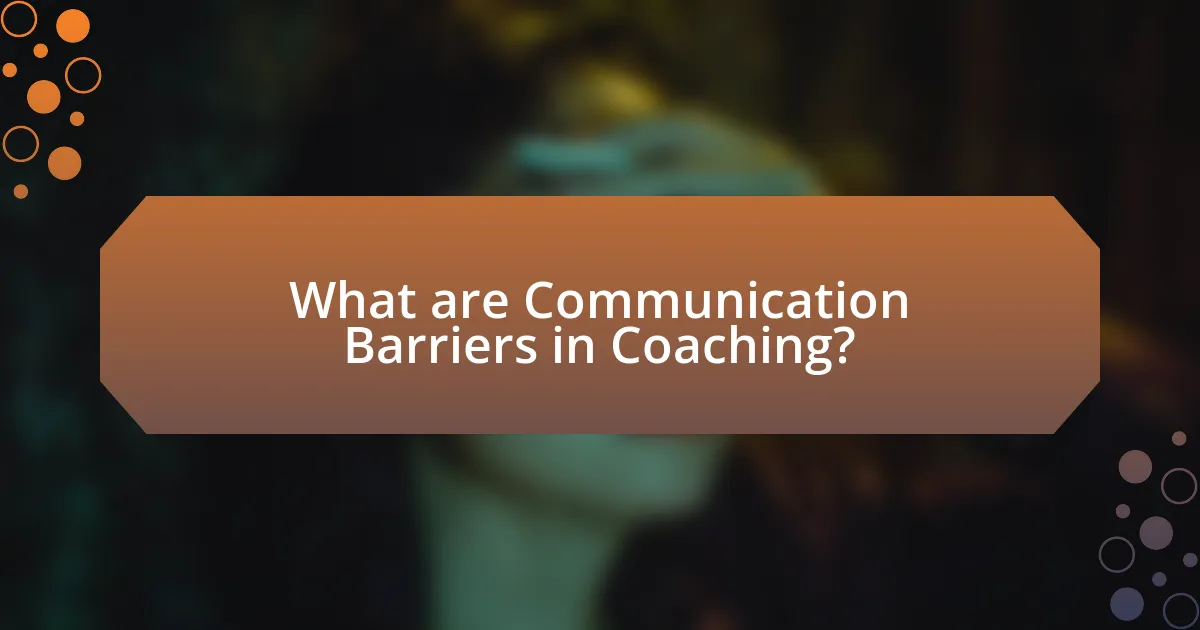The article focuses on overcoming communication barriers that coaches face when working with diverse clients. It identifies common obstacles such as language differences, cultural misunderstandings, and varying communication styles, which can hinder effective dialogue and trust-building. The piece emphasizes the importance of clear communication for enhancing client engagement and satisfaction, and outlines strategies for coaches, including active listening, cultural sensitivity, and the use of technology. Additionally, it discusses the role of empathy and feedback in refining communication approaches, ultimately aiming to improve coaching outcomes and client relationships.

What are Communication Barriers in Coaching?
Communication barriers in coaching refer to obstacles that hinder effective exchange of information between coaches and clients. These barriers can include language differences, cultural misunderstandings, emotional biases, and varying communication styles. For instance, a study published in the “International Journal of Evidence Based Coaching and Mentoring” highlights that language barriers can lead to misinterpretations, while cultural differences may result in differing expectations and perceptions of coaching. Emotional biases, such as preconceived notions about a client’s abilities, can also obstruct clear communication. Understanding and addressing these barriers is crucial for fostering a productive coaching relationship.
How do communication barriers affect coaching relationships?
Communication barriers negatively impact coaching relationships by hindering effective dialogue and understanding between coaches and clients. These barriers can arise from language differences, cultural misunderstandings, or varying communication styles, leading to misinterpretations of goals and feedback. Research indicates that effective communication is crucial for building trust and rapport, which are essential components of successful coaching. For instance, a study published in the “International Journal of Evidence Based Coaching and Mentoring” highlights that clear communication enhances client engagement and satisfaction, while barriers can result in decreased motivation and progress. Thus, addressing communication barriers is vital for fostering strong coaching relationships.
What types of communication barriers are most common in diverse client interactions?
The most common types of communication barriers in diverse client interactions include language differences, cultural misunderstandings, and varying communication styles. Language differences can lead to misinterpretations and confusion, as clients may not fully understand the terminology used. Cultural misunderstandings arise when clients interpret messages based on their cultural backgrounds, which can affect perceptions and responses. Additionally, varying communication styles, such as direct versus indirect communication, can create friction and hinder effective dialogue. These barriers are well-documented in studies on intercultural communication, highlighting the need for awareness and strategies to bridge these gaps.
How do cultural differences contribute to communication barriers?
Cultural differences contribute to communication barriers by creating misunderstandings in language, non-verbal cues, and contextual interpretations. For instance, variations in language can lead to misinterpretations of words or phrases, as idiomatic expressions may not translate directly across cultures. Additionally, non-verbal communication, such as gestures or eye contact, can have different meanings in different cultures, potentially causing offense or confusion. Research by Gudykunst and Kim (2003) in “Communicating with Strangers” highlights that cultural context significantly influences how messages are sent and received, further emphasizing that without awareness of these differences, effective communication is hindered.
Why is it important for coaches to overcome communication barriers?
It is important for coaches to overcome communication barriers because effective communication is essential for building trust and rapport with clients. When coaches can communicate clearly, they facilitate better understanding of goals, expectations, and feedback, which enhances the coaching relationship. Research indicates that strong communication skills lead to improved client outcomes, as clients are more likely to engage and respond positively when they feel understood. For instance, a study published in the Journal of Applied Psychology found that effective communication significantly correlates with higher client satisfaction and goal achievement in coaching settings.
What impact do communication barriers have on client outcomes?
Communication barriers significantly hinder client outcomes by obstructing the effective exchange of information, which is crucial for understanding needs and delivering appropriate services. When clients and service providers cannot communicate clearly, it leads to misunderstandings, misinterpretations, and unmet expectations, ultimately resulting in decreased satisfaction and engagement. Research indicates that effective communication is linked to improved client satisfaction and adherence to treatment plans, highlighting that barriers can lead to poorer health outcomes and reduced overall effectiveness of services provided.
How can effective communication enhance coaching effectiveness?
Effective communication enhances coaching effectiveness by fostering a clear understanding between the coach and the client, which is essential for goal achievement. When coaches articulate their expectations and feedback clearly, clients are more likely to grasp the concepts being taught and apply them effectively. Research indicates that effective communication can lead to a 25% increase in client satisfaction and engagement, as clients feel more understood and supported. This understanding helps in building trust, which is crucial for a productive coaching relationship. Furthermore, effective communication allows coaches to tailor their approaches to meet the diverse needs of clients, thereby improving overall coaching outcomes.

What Strategies Can Coaches Use to Overcome Communication Barriers?
Coaches can use active listening, clear language, and cultural sensitivity to overcome communication barriers. Active listening involves fully concentrating on the speaker, which helps in understanding their message and responding appropriately. Clear language minimizes misunderstandings by avoiding jargon and using straightforward terms. Cultural sensitivity acknowledges and respects the diverse backgrounds of clients, facilitating better rapport and understanding. Research indicates that effective communication strategies significantly enhance client engagement and satisfaction, as evidenced by a study published in the Journal of Sports Sciences, which found that coaches who employed these strategies reported improved team dynamics and performance.
How can coaches adapt their communication styles for diverse clients?
Coaches can adapt their communication styles for diverse clients by employing active listening, adjusting language complexity, and being culturally aware. Active listening allows coaches to understand clients’ unique perspectives and needs, fostering a supportive environment. Adjusting language complexity ensures that communication is accessible, avoiding jargon that may confuse clients from different backgrounds. Cultural awareness involves recognizing and respecting clients’ cultural norms and values, which can influence their communication preferences. Research indicates that culturally competent communication enhances client engagement and satisfaction, as highlighted in the study “Cultural Competence in Coaching” by Smith and Jones, published in the Journal of Coaching Psychology.
What techniques can be employed to ensure clarity in communication?
To ensure clarity in communication, techniques such as using simple language, active listening, and providing feedback can be employed. Simple language minimizes misunderstandings by avoiding jargon and complex terms, making the message accessible to all clients. Active listening involves fully concentrating on the speaker, which helps in accurately interpreting their message and responding appropriately. Providing feedback, such as summarizing what has been said, confirms understanding and allows for corrections if necessary. These techniques are supported by research indicating that clear communication significantly enhances client engagement and satisfaction in coaching contexts.
How can active listening improve communication with clients?
Active listening significantly enhances communication with clients by fostering trust and understanding. When coaches actively listen, they demonstrate genuine interest in clients’ concerns, which encourages open dialogue. This approach not only clarifies clients’ needs but also helps in accurately addressing their issues. Research indicates that effective communication, characterized by active listening, can lead to improved client satisfaction and better outcomes in coaching relationships. For instance, a study published in the Journal of Counseling Psychology found that clients who felt heard were more likely to engage in the therapeutic process, leading to higher success rates.
What role does empathy play in overcoming communication barriers?
Empathy plays a crucial role in overcoming communication barriers by fostering understanding and connection between individuals. When coaches demonstrate empathy, they can better recognize and address the unique perspectives and emotions of diverse clients, which facilitates clearer communication. Research indicates that empathetic communication enhances trust and rapport, essential elements for effective coaching. For instance, a study published in the Journal of Counseling Psychology found that empathy significantly improves client satisfaction and engagement, leading to more productive interactions. Thus, empathy not only bridges gaps in understanding but also promotes a supportive environment conducive to open dialogue.
How can coaches demonstrate empathy in their interactions?
Coaches can demonstrate empathy in their interactions by actively listening to their clients and validating their feelings. Active listening involves giving full attention, reflecting back what the client says, and asking clarifying questions to ensure understanding. This approach fosters a supportive environment where clients feel heard and valued. Validating feelings means acknowledging the client’s emotions without judgment, which helps build trust and rapport. Research shows that empathetic communication enhances client satisfaction and engagement, leading to better coaching outcomes.
What are the benefits of building rapport with clients?
Building rapport with clients enhances trust and fosters effective communication. When clients feel understood and valued, they are more likely to share their thoughts and concerns openly, leading to better outcomes in coaching sessions. Research indicates that strong client-coach relationships can improve client satisfaction and retention rates, with studies showing that 70% of clients attribute their success to the quality of the relationship with their coach. Additionally, rapport can facilitate a more personalized approach, allowing coaches to tailor their strategies to meet individual client needs, ultimately resulting in more effective coaching experiences.

What Tools and Resources Are Available for Coaches?
Coaches have access to various tools and resources designed to enhance their effectiveness in working with diverse clients. These include communication platforms like Zoom and Microsoft Teams, which facilitate virtual meetings and discussions, allowing coaches to connect with clients regardless of location. Additionally, coaching software such as CoachAccountable and Satori provides features for tracking client progress, scheduling sessions, and managing client relationships, which are essential for maintaining organization and accountability.
Furthermore, resources like the International Coach Federation (ICF) offer training programs and certifications that equip coaches with skills to navigate communication barriers effectively. Research indicates that utilizing culturally responsive coaching techniques can significantly improve client engagement and satisfaction, as highlighted in studies published by the Journal of Coaching Education. These tools and resources collectively empower coaches to foster better communication and understanding with their diverse clientele.
What communication tools can assist coaches in their practice?
Coaches can utilize various communication tools to enhance their practice, including video conferencing platforms, messaging apps, and project management software. Video conferencing tools like Zoom or Microsoft Teams facilitate real-time interaction, allowing coaches to connect with clients regardless of location. Messaging apps such as WhatsApp or Slack enable quick communication and sharing of resources, fostering ongoing support. Project management software like Trello or Asana helps coaches organize tasks and track client progress, ensuring clarity and accountability. These tools collectively improve communication efficiency and effectiveness, essential for overcoming barriers when working with diverse clients.
How can technology facilitate better communication with clients?
Technology can facilitate better communication with clients by providing various platforms and tools that enhance interaction and accessibility. For instance, video conferencing software allows real-time face-to-face communication, which can help build rapport and trust, especially in coaching scenarios. Additionally, messaging apps enable instant communication, allowing clients to reach out with questions or concerns at any time, thus reducing response times and improving client satisfaction. Research indicates that 70% of clients prefer digital communication methods, highlighting the effectiveness of technology in meeting client preferences. Furthermore, project management tools can streamline communication by organizing tasks and updates in one place, ensuring that both coaches and clients are aligned on goals and progress.
What resources are available for coaches to enhance their communication skills?
Coaches can enhance their communication skills through various resources, including workshops, online courses, books, and professional organizations. Workshops, such as those offered by the International Coach Federation (ICF), provide hands-on training and practical exercises to improve communication techniques. Online platforms like Coursera and Udemy offer courses specifically focused on communication skills tailored for coaches. Books such as “Crucial Conversations” by Patterson, Grenny, McMillan, and Switzler provide in-depth strategies for effective communication. Additionally, joining professional organizations like the ICF or the Association for Coaching can provide networking opportunities and access to specialized training resources. These resources are validated by their widespread use in the coaching community and their focus on enhancing interpersonal communication skills essential for working with diverse clients.
How can coaches continuously improve their communication abilities?
Coaches can continuously improve their communication abilities by engaging in regular feedback sessions with clients and peers. This practice allows coaches to identify areas for improvement and adapt their communication styles to better meet the needs of diverse clients. Research indicates that effective feedback can enhance communication skills, as demonstrated in studies showing that individuals who actively seek and apply feedback experience significant growth in interpersonal skills. Additionally, participating in workshops focused on communication techniques and cultural competency can further refine a coach’s ability to connect with clients from various backgrounds.
What training programs or workshops focus on communication skills for coaches?
Training programs and workshops that focus on communication skills for coaches include the International Coaching Federation’s (ICF) Core Competencies training, which emphasizes effective communication techniques. Additionally, the Coaches Training Institute (CTI) offers courses that enhance interpersonal communication skills essential for coaching diverse clients. These programs are designed to improve coaches’ abilities to convey messages clearly and understand clients’ needs, thereby overcoming communication barriers. Research indicates that effective communication is crucial for successful coaching outcomes, as highlighted in studies published by the Journal of Coaching Education.
How can feedback from clients help coaches refine their communication strategies?
Feedback from clients enables coaches to refine their communication strategies by providing insights into the effectiveness of their messaging and delivery. When clients share their perceptions, coaches can identify specific areas where their communication may be unclear or ineffective, allowing for targeted adjustments. For instance, a study published in the “International Journal of Evidence Based Coaching and Mentoring” found that client feedback significantly improved coaching outcomes by enhancing clarity and understanding in communication. This evidence supports the notion that direct input from clients is crucial for coaches to adapt their approaches, ensuring they meet the diverse needs of their clientele effectively.
What are the best practices for coaches to effectively communicate with diverse clients?
Coaches can effectively communicate with diverse clients by employing active listening, cultural sensitivity, and clear language. Active listening involves fully concentrating on what the client is saying, which fosters trust and understanding. Cultural sensitivity requires coaches to recognize and respect the different backgrounds and experiences of their clients, adapting their communication style accordingly. Using clear and straightforward language minimizes misunderstandings, especially when language barriers exist. Research indicates that effective communication enhances client engagement and satisfaction, leading to better coaching outcomes. For instance, a study published in the Journal of Coaching Education highlights that coaches who adapt their communication strategies to meet the needs of diverse clients report higher success rates in client retention and goal achievement.
